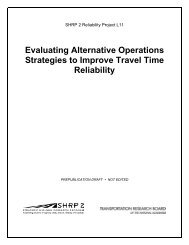Mileage-Based User Fee Winners and Losers - RAND Corporation
Mileage-Based User Fee Winners and Losers - RAND Corporation
Mileage-Based User Fee Winners and Losers - RAND Corporation
You also want an ePaper? Increase the reach of your titles
YUMPU automatically turns print PDFs into web optimized ePapers that Google loves.
calculated by taking the partial derivative of the dem<strong>and</strong> function in Equation 3.2 with respect to<br />
price as shown in Equation 3.3:<br />
lnM<br />
ln<br />
p<br />
i<br />
i<br />
= β 1 + β 7 lnY i + β 8 lnMPG i + (β V2 + β V3 ) (3.3)<br />
Each household has only one of the parameters β V2 & β V3 factor into their price elasticity depending<br />
on the number of household vehicles (with no parameter for a household with only one vehicle).<br />
The mean price elasticity is -0.43, a value that is close to the β 1 coefficient in the linear model<br />
fitted with pooled data, as is expected. The most elastic value is -0.98, which is still inelastic, <strong>and</strong> the<br />
maximum value is 0.02. A positive value for price elasticity is somewhat unexpected because it<br />
means that these households increase VMT as the price of driving increases. 137 observations,<br />
representing less than 0.1 percent of the population, have a positive price elasticity. The distribution<br />
of price elasticity in the population, as illustrated in Figure 3.1, is bi-modal. This is not directly<br />
attributable to income but, as illustrated in Figure 3.2, to vehicle ownership. The predicted price<br />
elasticities for households with more than 2 vehicles lie predominately between zero <strong>and</strong> the average,<br />
while the predicted price elasticities for households with one to two vehicles lie predominately<br />
between the average <strong>and</strong> -1. Household vehicle ownership is associated with many correlated factors<br />
including income, unobserved derived dem<strong>and</strong> for travel, <strong>and</strong> characteristics of the built<br />
environment (such as the density of development, availability of parking, urban traffic congestion,<br />
<strong>and</strong> access to alternative modes of travel).<br />
It is difficult to interpret the results, however, <strong>and</strong> the reader should not mistake correlation,<br />
in this case, with causality. Household dem<strong>and</strong> for VMT is the product of l<strong>and</strong> use, income<br />
(including the price of travel relative to the prices of all other consumer goods), <strong>and</strong> household<br />
preferences <strong>and</strong> consumption, which are all factors that are imperfectly or indirectly measured by the<br />
NHTS instrument.<br />
Predictors of Household Dem<strong>and</strong> for VMT<br />
This section describes each of the predictors of household dem<strong>and</strong> for VMT. The reasoning<br />
for including each variable is discussed as well as the expected <strong>and</strong> actual effect on the dem<strong>and</strong> for<br />
travel. The expected <strong>and</strong> actual effect on the estimated price elasticity of variables that are interacted<br />
with the natural log of price is also discussed. The technical details regarding how each variable was<br />
constructed is assumed to be of interest to a limited audience <strong>and</strong> these are provided in the<br />
Technical Appendix.<br />
Price per Mile<br />
The price per mile of travel is a composite variable based on the VMT-weighted average fuel<br />
price of household vehicles divided by the VMT-weighted average household MPG. The price is<br />
disaggregated into the cost of fuel <strong>and</strong> state <strong>and</strong> federal taxes in order to facilitate the distributional<br />
analysis of alternative tax policies (in which the federal <strong>and</strong> state fuel excise tax rates are either<br />
increased or, depending on the alternative being assessed, replaced by or supplemented with MBUFs<br />
of various rates <strong>and</strong> designs). In fitting the model, however, the current retail prices, as reported in<br />
the NHTS data are used to calculate this variable.<br />
Page 32 of 131















